Deployment Challenges in Electromagnetic Wireless Nanosensor Networks
Abstract
1. Introduction
- Graphene antennas: The graphene-based antennas used in NSs are a direct consequence of their extremely small size. Studies have shown that the electromagnetic properties of these antennas, particularly when operating in the Terahertz (THz) band (0.1–10.0 THz), make them the most suitable option for communication between NSs over distances ranging from hundreds to thousands of nanometers [5]. Moreover, the use of the Terahertz band offers several advantages for nanoscale communication:
- It enables NSs to transmit and receive information with very large bandwidth, thereby supporting the use of simple communication and medium-sharing mechanisms [4]. Nevertheless, the Terahertz band suffers from very high propagation loss. Combined with the limited energy of NSs, this loss imposes significant limitations on the communication range of NSs [13].
- The band offers a high bit rate and short transmission time, which reduce the probability of collisions [14].
- Communication between NSs requires the use of Media Access Control (MAC) protocols to coordinate access to the channel and manage concurrent transmissions. However, well-known MAC protocols are not suitable for this type of communication due to the previously mentioned constraints [4,5]. Therefore, novel MAC protocols tailored for WNSNs are required.
2. Types of Electromagnetic Nanosensors
- Physical NSs: They are miniature sensing devices typically constructed from nanomaterials. These materials provide high sensitivity and ultra-low power operation, enabling the detection of physical parameters such as pressure, vibration, temperature, and mechanical deformation. Emerging quantum nanosensors offer even higher precision, potentially improving network performance [17]. In electromagnetic WNSNs, physical nanosensors are particularly relevant due to their compatibility with THz-band communication and integration with graphene-based nanoantennas. Their small size and limited energy capacity directly impact deployment considerations, influencing achievable sensing density, communication range, and energy consumption [18,19].
- Chemical NSs: They exploit nanostructured materials with high surface-to-volume ratios, such as functionalized graphene, metal oxides, or thin nanofilms, to detect chemical substances. Their high sensitivity enables detection of gases, ions, and molecular concentrations, making them suitable for environmental monitoring and industrial applications. In electromagnetic WNSNs, chemical nanosensors are typically stationary, and their performance is affected by environmental variations that influence THz propagation. Coupled with their ultra-low-power requirements, these characteristics directly shape node placement strategies, required sensor density, and energy management within deployment frameworks [20].
- Biological NSs: They are composed of two essential components: a bioreceptor and a signal transducer. When the bioreceptor detects any change in the targeted biomolecules, the signal transducer converts this change into a measurable output [21]. They are widely used in biomedical contexts for monitoring proteins, pathogens, metabolites, or cellular activity. Their operation in highly heterogeneous biological environments introduces deployment constraints such as limited communication range, strong THz absorption, and mobility restrictions within tissues or organs. As a result, deployment strategies for electromagnetic WNSNs using biological nanosensors must consider spatial distribution inside biological media, reliable communication, and energy-efficiency to ensure accurate and continuous physiological monitoring.
3. WNSN Applications
3.1. Medical Applications
3.2. Military Applications
3.3. Environmental Applications
3.4. Intelligent Food Packing Applications
3.5. Smart Offices
4. WNSN Characteristics
4.1. WNSNs Architecture
- Nanosensors (NSs): These are small devices with sizes typically around 10–100 m [10]. They can perform only simple tasks, such as sensing, actuation in the small area around them, or basic computation. The density of NSs deployed in a WNSN is a major factor affecting network performance [15]. NS density depends on the size of the target area and the total number of NSs deployed. In general, NSs in WNSNs are expected to be deployed at high density, meaning a large number of NSs in a small area.
- Nanorouters (or Nanocontrollers, NCs [13]): These are devices with greater computational capabilities than NSs. When deployed, they typically manage NSs within their cluster by performing three essential tasks using short messages [16,30]:
- (a)
- Scheduling NSs activities;
- (b)
- Gathering NSs data;
- (c)
- Directing NSs movements in dynamic deployments.
- Nanogateways (NGs, or Micro-gateways, MGs): These are devices that collect information from the entire WNSN and forward it to other networks or devices, such as Wi-Fi, 5G, or LTE [31].
4.2. Differences Between Sensors and Nanosensors
5. WNSN Challenges
5.1. Nano Batteries
- The limited energy that can be stored in NSs due to the small size of nano-batteries, which is typically sufficient to exchange only a few hundred bits at a time [6];
- The infeasibility of replacing or recharging the NS batteries when WNSNs are deployed with a large number of NSs over extensive geographical areas or in hostile environments [36].
- Energy from the surrounding environment: Whenever WNSN is deployed in an environment, where there is enough mechanical energy to power all NSs, exploiting such energy can represent the more convenient option for the energy harvesting system to utilize it as a source for the energy as discussed in [7].
- Energy from the Wireless Power Transfer (WPT): WPT is an external device with ultrasound, used in piezoelectric nano-generators to vibrate and create compress–release cycles to extract energy from as presented in [22]. The usefulness of this device, as a power supply, is that it guarantees a constant energy harvesting rate regardless of the environments’ conditions as presented in [37], where a bistable piezoelectric device is proposed for activating a noise in response to the frequency available in the medium. Then, the device is designed to convert vibrations generated by the noise into electrical energy.
5.2. Nano Antennas
- It has a high bit rate and short transmission time, which minimizes the probability of collisions [14].
5.3. Nano-Processors
- Regulate NSs access to the channel.
- Coordinate and synchronize NSs transmissions.
- The limited computational powers of NSs, which enable the introduction of new protocols with ultra low complexity.
- The distinctive properties of the Terahertz band such as very high propagation loss lead to limited transmission range. The propagation loss is affected directly by the distance between the communicating NSs. Therefore, a tightly synchronized access to the channel is required.
- The fluctuation of NSs energy, caused by the utilization of energy harvesting systems as mentioned earlier.
6. WNSN Deployment
- A sufficient sensing coverage for the target area (full or partial);
- Optimize NSs energy consumption to ensure the required lifetime for the network (perpetual or temporal);
- The continuous connectivity between NSs at all times.
- WNSNs can be deployed with either fixed locations for the NDs serving in the network (static deployment) as in industrial applications where NSs are used to monitor and control machines and devices remotely [41], or in areas where NSs are constantly moving (dynamic deployment), as in healthcare applications where NSs travel through the bloodstream inside the human body [15]. Later, we will present different proposals developed for both types of deployments.
- NSs Density: Some applications (e.g., applications for sensing and monitoring battlefields) require a very high density of NSs to be deployed over a large field to guarantee a satisfactory level of coverage for the target area. Other applications (like applications for monitoring soldier’s performance) require deploying NSs in a small area where fewer number of NSs can provide sufficient coverage [16].
- NDs could stack on a specific area, causing an excessive coverage for that area leading to huge waste of NDs energies, while other areas are lacking the proper coverage.
- NDs could scatter around the environment, leading to the loss of connectivity between them. This scattering could create holes in the network’s coverage and connectivity [35].
6.1. WNSN Topologies
- Selection of Communication Techniques: Since the limited energy of NSs is a major issue for WNSNs, the selection of communication protocols and schemes is a vital consideration. Therefore, the effect of the network topology on the energy consumption of the employed communication protocol must be taken into account.
6.1.1. Centralized Topology
- Cluster model: The cluster model, as shown in Figure 2, is where the WNSN is divided into clusters with multiple layers. Each cluster is formed based on locations. At the lowest layer of the cluster, NSs reside as the smallest nodes with the least capabilities. Meanwhile, all NSs in one cluster are managed and organized by the layer above containing NCs. NCs communicate with all NSs in their cluster through single or multiple hops. This layer helps in shifting the complexity of the protocols and algorithms from NSs into NCs, to adapt with the limited resources of NSs. At the top layer, a gateway is positioned to ensure the connection between NCs and a macro device, such as computer or a smart phone. When assigning NSs to a specific cluster, the communication between them and the center of the cluster must be guaranteed by assuring a successful arrival for the packets to the center. Different attributes affect the received Terahetz signal, carrying the information, which will be discussed in detail on Section 6.5. According to [22], while such a model is not suitable for dynamic WNSNs (where NSs are in constant moving state), it helps in reducing the energy required for data transmission, by optimizing the network address using subranges for each cluster in static WNSNs. Furthermore, cluster model facilitates the design of energy efficient communication techniques for the WNSN, where each NS can adjust its energy to adapt with different transmission parameters, such as transmission power, number of hops and so on.Such a model is proposed in [43] for the WNSN framework. The first step of the proposal, after deploying NSs uniformly in the target area, is to classify NSs in the WNSN into one of three cluster types: corner nodes, border nodes, and center nodes. The classification process is performed by calculating the density of each cluster type, according to some equations. Then, compare the values with the number of broadcasted packets for each NS. Thereafter accordingly, NSs are classified into a specific cluster type. Then, the second step in the proposal is to select an NS as a cluster head, rather than an NC, in each cluster type. The cluster head is chosen based on the following attributes:
- Ratio of the NS residual energy to the NS average energy.
- Number of neighboring NSs.
- Number of times the NS was selected as the cluster head.
- The distance between the cluster heads of all cluster types.
The authors concluded that the proposed protocol reduced the energy consumed by WNSN in comparison with algorithms in which cluster heads are selected based on the residual energy only. However, the proposal did not detail any consideration for the Terahetz band peculiarities. The effect of the deployment attributes, frequency range, distance between communicating NSs and molecular composition, on the Terahertz signal has to be considered in any WNSN topology to guarantee the successful reception of the packets to their destination. - Infrastructure Model: The infrastructure model is the most suitable for applications in which the WNSN exhibits constant movement (mobile WNSNs), such as networks operating within the bloodstream. In this model, NCs are pre-stationed at fixed locations. As NSs move, they are not linked to a specific NC; instead, they transmit information to any NC within their current coverage range. All NCs then forward the collected data to the gateway, resulting in the highest energy consumption occurring at the NCs. However, since NCs possess greater energy storage capacity, this is considered advantageous. Moreover, due to their fixed positions, NCs can exploit external energy sources for continuous power supply. Meanwhile, NSs are activated only after harvesting sufficient energy from the surrounding medium to transmit information to the nearest NC. Nevertheless, a key concern in this model is the large number of NSs, each requiring a unique address, which significantly increases the number of bits needed for addressing. The primary application associated with this topology is Body Area Nanonetworks (BANNs). Figure 3 illustrates an example of WNSN operating under an infrastructure topology. However, the transmission power of NSs is constrained by the technology used to manufacture their antennas [13]. As a result, the transmission range—within which packets can be successfully received by another ND—is very limited. Therefore, when deploying a WNSN in an infrastructure topology, the placement of NCs must account for the various attributes affecting the Terahertz signal to ensure that any moving NS can successfully transmit its packets to at least one NC. The attributes influencing Terahertz signal reception are discussed in Section 6.5.
6.1.2. Distributed Topology
6.2. WNSN Deployment Types
6.2.1. The Deployment of Static NSs
- Star topology: All NSs are connected to a central device via dedicated calcium signaling channels. The central device is responsible for facilitating the communication between any two NSs.
- Bus topology: All NSs are connected via a bus of calcium cells. Any NS can send data to another NS by triggering the calcium cell closest to it to send a signal representing the data. The signal keeps propagating through the bus of cells until it reaches the closest cell to the receiver. Then, the receiver cell will decode the information and send it to the receiving NS using another molecular communication scheme.
- A grid topology: Only a sink node is deployed and calcium cells are used as NSs, exploiting the signaling capability of calcium cells. The grid is formed by calcium cells division, around the sink, until it reaches a certain distance as required.
6.2.2. The Deployment of Dynamic NSs
- Initialize the current positions and velocities for all particles in the field. Then, set the first position as the best position for each particle.
- All particles start executing the fitness function. Then, each particle starts comparing the result to their own best position. If the fitness function result is better, then change the best position to the new value obtained from the fitness function.
- Compare the best positions of all particles and set the best position as the global best position.
- Update all velocities and positions for all particles based on the global best position and move the particles to the new positions.
6.3. Connectivity Between Nanosensors
- Using flood-based schemes for transmitting packets: unfortunately, it usually causes a broadcast storm due to the high density of NSs in WNSNs which leads to the problem of redundancy and collision.
- Utilizing the dynamic infrastructure approach (DIF) [53,56]: It is proposed to reduce packet retransmission rate without affecting the network connectivity. The main idea of the DIF is that NSs, with good-quality reception, are the only nodes allowed to retransmit packets; they are called infrastructure NSs. Other NSs that operate on receiving mode only are called user NSs. The process of classifying the mode for each NS to operate on is run by each NS locally (called the Maturity Process). The process is based on the NS packet reception statistics. As a result, the NS will decide whether it is better to mature to infrastructure and take the role of retransmission, or to stay as a user. Even though the DIF provides a better energy-efficient scheme than the first approach, it still suffers from flooding the network with retransmitted packets even when it is not necessary.
- Clustering-based hop-counting mechanism is presented in [54]. In this mechanism, NSs are grouped into clusters, and only the cluster leaders are allowed to communicate with one another. The main objective of the mechanism is to reduce the number of retransmissions while ensuring a high packet arrival rate.
- An efficient data dissemination scheme was proposed in [59] for an application inside the human body. In the proposal, multiple mobile NSs are deployed inside the human body traveling with the bloodstream. Furthermore, multiple NCs and 1 NG are deployed in prefixed positions, where the NG is stationed at the middle of the artery and it is the destination for all NS packets. The proposal aims to reduce the amount of energy consumed by the WNSN while maintaining the packet transmissions ratio. For that, the scheme starts with all NCs broadcasting their locations to all NSs in the WNSN. Next, each NS will start identifying the closest NC to it, based on the distance separating them. When a NS is ready to transmit packets to the NG, it first checks whether the NG is within its transmission range. If so, the NS transmits the packets directly. If not, it checks whether the nearest NC is within range and, if available, transmits the packets to the NC, which then forwards them to the NG. Otherwise, the NS sends its packets to the nearest neighboring NS that is closer to the NC. Compared to the flooding approach, the proposed scheme has been shown to reduce energy consumption while maintaining a high packet transmission rate.
6.4. WNSN Coverage
- Non-unit disk, when the sensing range of NSs differs [61].
- In 2D environments [62]: It has been proved that positioning sensors in a triangular lattice, as shown in Figure 2, will result in an optimal deployment when the following conditions are met:
- There is a fixed distance between NSs ().
- Sensors have a sensing range (r).
- Each sensor is located at a triangle vertex and has 6 neighboring sensors.
- The full coverage is achieved when the distance between the sensors is calculated as
- Consequently the full connectivity is achieved when the transmission range () is defined as
- In 3D environments [63]: The optimal deployment can be obtained by a truncated octahedron placement for the sensors, where each sensor has 14 neighboring sensors. The truncated octahedron has 14 faces (8 faces are regular hexagons, and 6 faces are squares). In such a placement, to achieve optimal deployment, the distance between sensors can be defined based on the type of the face they are in, as follows:
- In a square face:
- In a hexagonal face:
6.5. Terahertz Channel Models
6.5.1. Terahertz Signal Attenuation
6.5.2. Noise in Terahertz Channel
6.5.3. Therahertz Channel Bandwidth
6.5.4. Terahertz Signal Total Transmission Power
6.5.5. Terahertz
6.5.6. Terahertz Received Signal Power
6.6. Comparative Analysis of Deployment Metrics
7. Conclusions
- The extent of the WNSN coverage; the coverage of the area could either be full coverage for the entire deployment field or partial coverage, where only covering a part of the field can achieve the application’s mission.
- The type of coverage required for the target area, whether a 1-coverage is enough or k-coverage is required to ensure the fulfillment of the application’s mission.
- WNSN lifetime, whether the network is expected to have a perpetual lifetime which requires the utilization of the energy harvesting systems with a steady source of energy, or temporal lifetime where energy harvesting systems can depend on the existing energy sources in the medium.
- The placement of the NSs in the field, whether they start with fixed positions defined based on some attributes to guarantee the coverage and connectivity, or the deployment starts with a random positioning for NSs, in which case self-deployment for NSs is required.
- The mobility of the WNSNs, whether the NDs are required to move constantly in the environment, or once they reach their optimal positions they are required to maintain them until the application’s mission is completed.
- The dimensions in which the WNSN is deployed, whether it is a 2D environment where all NDs have the same height, or 3D environment where NDs are positioned with (x,y,z) coordinates.
- The topology of WNSN and the distances between NDs to guarantee the continuous connectivity between them.
Future Work and Research Directions
Author Contributions
Funding
Data Availability Statement
Acknowledgments
Conflicts of Interest
References
- Javaid, M.; Haleem, A.; Singh, R.P.; Rab, S.; Suman, R. Exploring the potential of nanosensors: A brief overview. Sens. Int. 2021, 2, 100130. [Google Scholar] [CrossRef]
- Usibe, B.E.; Menkiti, A.I.; Onuu, M.U.; Ogbulezie, J.C. Development and analysis of a potential nanosensor communication network using carbon nanotubes. Int. J. Mater. Eng. 2013, 3, 4–10. [Google Scholar]
- Oukhatar, A.; Bakhouya, M.; El Ouadghiri, D. Electromagnetic-Based Wireless Nano-Sensors Network: Architectures and Applications. J. Commun. 2021, 16, 8–19. [Google Scholar] [CrossRef]
- Jornet, J.M.; Pujol, J.C.; Pareta, J.S. Phlame: A physical layer aware mac protocol for electromagnetic nanonetworks in the terahertz band. Nano Commun. Netw. 2012, 3, 74–81. [Google Scholar] [CrossRef]
- D’Oro, S.; Galluccio, L.; Morabito, G.; Palazzo, S. A timing channel-based MAC protocol for energy-efficient nanonetworks. Nano Commun. Netw. 2015, 6, 39–50. [Google Scholar] [CrossRef]
- Mohrehkesh, S.; Weigle, M.C. RIH-MAC: Receiver-initiated harvesting aware MAC for nanonetworks. In Proceedings of the First Annual International Conference on Nanoscale Computing and Communication, Atlanta, GA, USA, 6–9 May 2014; ACM: New York, NY, USA, 2014; p. 6. [Google Scholar]
- Abandankeshi, M.J.A.; AbdLatiff, M.S. Acoustic energy conversion for mobile nanosensor network communication. In Proceedings of the 2011 IEEE Conference on Sustainable Utilization and Development in Engineering and Technology (STUDENT), Semenyih, Malaysia, 20–21 October 2011; pp. 133–137. [Google Scholar]
- Nafari, M.; Jornet, J.M. Metallic plasmonic nano-antenna for wireless optical communication in intra-body nanonetworks. In Proceedings of the 10th EAI International Conference on Body Area Networks, ICST (The Institute for Computer Sciences, Social Informatics and Telecommunications Engineering), Sydney, Australia, 28–30 September 2015; pp. 287–293. [Google Scholar]
- Islam, M.S.; Vj, L. Nanoscale materials and devices for future communication networks. IEEE Commun. Mag. 2010, 48, 112–120. [Google Scholar] [CrossRef]
- Akyildiz, I.F.; Jornet, J.M. Electromagnetic wireless nanosensor networks. Nano Commun. Netw. 2010, 1, 3–19. [Google Scholar] [CrossRef]
- Haroun, A.F.; Le, X.; Gao, S.; Dong, B.; He, T.; Zhang, Z.; Wen, F.; Xu, S.; Lee, C. Progress in micro/nano sensors and nanoenergy for future AIoT-based smart home applications. Nano Express 2021, 2, 022005. [Google Scholar] [CrossRef]
- Jornet, J.M.; Akyildiz, I.F. Joint energy harvesting and communication analysis for perpetual wireless nanosensor networks in the terahertz band. IEEE Trans. Nanotechnol. 2012, 11, 570–580. [Google Scholar] [CrossRef]
- Wang, P.; Jornet, J.M.; Malik, M.G.A.; Akkari, N.; Akyildiz, I.F. Energy and spectrum-aware MAC protocol for perpetual wireless nanosensor networks in the Terahertz Band. Ad Hoc Netw. 2013, 11, 2541–2555. [Google Scholar] [CrossRef]
- Xia, Q.; Hossain, Z.; Medley, M.; Jornet, J.M. A link-layer synchronization and medium access control protocol for terahertz-band communication networks. In Proceedings of the 2015 IEEE Global Communications Conference (GLOBECOM), San Diego, CA, USA, 6–10 December 2015; pp. 1–7. [Google Scholar]
- Rupani, V.; Kargathara, S.; Sureja, J. A review on wireless nanosensor networks based on electromagnetic communication. Int. J. Comput. Sci. Inf. Technol. 2015, 6, 1019–1022. [Google Scholar]
- Akyildiz, I.F.; Brunetti, F.; Blazquez, C. Nanonetworks: A new communication paradigm. Comput. Netw. 2008, 52, 2260–2279. [Google Scholar] [CrossRef]
- Nikolaev, V.V.; Lepekhina, T.B.; Alliluev, A.S.; Bidram, E.; Sokolov, P.M.; Nabiev, I.R.; Kistenev, Y.V. Quantum Dot-Based Nanosensors for In Vitro Detection of Mycobacterium tuberculosis. Nanomaterials 2024, 14, 1553. [Google Scholar] [CrossRef] [PubMed]
- Dhahi, T.S.; Dafhalla, A.K.Y.; Tayfour, O.E.; Mubarakali, A.; Alqahtani, A.S.; Tayfour, A.E.A.; Elobaid, M.E.; Adam, T.; Gopinath, S.C.B. Advances in nano sensors for monitoring and optimal performance enhancement in photovoltaic cells. iScience 2024, 27, 109347. [Google Scholar] [CrossRef]
- Sadeghi, S.M. Plasmonic metaresonance nanosensors: Ultrasensitive tunable optical sensors based on nanoparticle molecules. IEEE Trans. Nanotechnol. 2011, 10, 566–571. [Google Scholar] [CrossRef]
- Li, T.; Yin, W.; Gao, S.; Sun, Y.; Xu, P.; Wu, S.; Kong, H.; Yang, G.; Wei, G. The Combination of Two-Dimensional Nanomaterials with Metal Oxide Nanoparticles for Gas Sensors: A Review. Nanomaterials 2022, 12, 982. [Google Scholar] [CrossRef] [PubMed] [PubMed Central]
- Vo-Dinh, T.; Cullum, B.M.; Stokes, D.L. Nanosensors and biochips: Frontiers in biomolecular diagnostics. Sens. Actuators B Chem. 2001, 74, 2–11. [Google Scholar] [CrossRef]
- Carrasco, S.C.; Sanchez, A.J.G.; Haro, J.G. On the Nature of Energy-Feasible Wireless Nanosensor Networks. Sensors 2018, 18, 1356. [Google Scholar] [CrossRef] [PubMed]
- Mannoor, M.S.; Tao, H.; Clayton, J.D.; Sengupta, A.; Kaplan, D.L.; Naik, R.R.; Verma, N.; Omenetto, F.G.; McAlpine, M.C. Graphene-based wireless bacteria detection on tooth enamel. Nat. Commun. 2012, 3, 763. [Google Scholar] [CrossRef]
- Boualem, A.; Fouchal, H.; Ayaida, M.; Kholidy, H. Diagnosis of Infectious Diseases using Nano Sensors Network in Nanofluids. BioNanoSci. 2025, 15, 394. [Google Scholar] [CrossRef]
- Jaiswal, L.; Limayem, A.; Shankar, S. Polysaccharide-based nanomaterials. In Food, Medical, and Environmental Applications of Nanomaterials; Elsevier: Amsterdam, The Netherlands, 2022; pp. 95–111. [Google Scholar]
- Pummakarnchana, O.; Tripathi, N.; Dutta, J. Air pollution monitoring and GIS modeling: A new use of nanotechnology based solid state gas sensors. Sci. Technol. Adv. Mater. 2005, 6, 251. [Google Scholar] [CrossRef]
- Hari, N.; Radhakrishnan, S.; Nair, A.J. Nanosensors as potential multisensor systems to ensure safe and quality food. In Biotechnological Approaches in Food Adulterants; CRC Press: Boca Raton, FL, USA, 2020; pp. 204–238. [Google Scholar]
- Fuertes, G.; Soto, I.; Carrasco, R.; Vargas, M.; Sabattin, J.; Lagos, C. Intelligent packaging systems: Sensors and nanosensors to monitor food quality and safety. J. Sens. 2016, 2016, 4046061. [Google Scholar] [CrossRef]
- Boronin, P.; Petrov, V.; Moltchanov, D.; Koucheryavy, Y.; Jornet, J.M. Capacity and throughput analysis of nanoscale machine communication through transparency windows in the terahertz band. Nano Commun. Netw. 2014, 5, 72–82. [Google Scholar] [CrossRef]
- Abbasi, M.; AbdLatiff, M.S. Mobility Control to Improve Nanosensor Network Lifetime based on Particle Swarm Optimization. Int. J. Comput. Appl. 2011, 975, 8887. [Google Scholar]
- Pirmagomedov, R.; Kirichek, R.; Blinnikov, M.; Koucheryavy, A. UAV-based gateways for wireless nanosensor networks deployed over large areas. Comput. Commun. 2019, 146, 55–62. [Google Scholar] [CrossRef]
- Microwaves & RF. Available online: https://www.mwrf.com/ (accessed on 20 April 2022).
- Hla, K.H.S.; Choi, Y.; Park, J.S. Self organized mobility in nanosensor network based on particle swarm optimization and coverage criteria. In Proceedings of the IEEE 2008 Fourth International Conference on Networked Computing and Advanced Information Management (NCM’08), Gyeongju, Republic of Korea, 2–4 September 2008; Volume 1, pp. 636–641. [Google Scholar]
- ResearchGate. Available online: https://www.researchgate.net/ (accessed on 1 March 2020).
- Rehmani, M.H.; Pathan, A.K. Emerging Communication Technologies Based on Wireless Sensor Networks: Current Research and Future Applications; CRC Press: Boca Raton, FL, USA, 2016. [Google Scholar]
- Wang, Z.L. Towards self-powered nanosystems: From nanogenerators to nanopiezotronics. Adv. Funct. Mater. 2008, 18, 3553–3567. [Google Scholar] [CrossRef]
- Cottone, F.; Vocca, H.; Gammaitoni, L. Nonlinear energy harvesting. Phys. Rev. Lett. 2009, 102, 080601. [Google Scholar] [CrossRef]
- Jornet, J.M.; Akyildiz, I.F. Channel modeling and capacity analysis for electromagnetic wireless nanonetworks in the terahertz band. IEEE Trans. Wireless Commun. 2011, 10, 3211–3221. [Google Scholar] [CrossRef]
- Xie, J.; Ren, Z.; Wei, J.; Liu, W.; Zhou, J.; Lee, C. Zero-bias long-wave infrared nanoantenna-mediated graphene photodetector for polarimetric and spectroscopic sensing. Adv. Opt. Mater. 2023, 11, 2202867. [Google Scholar] [CrossRef]
- Avouris, P.; Chen, Z.; Perebeinos, V. Carbon-based electronics. In Nanoscience and Technology: A Collection of Reviews from Nature Journals; World Scientific: Singapore, 2010; pp. 174–184. [Google Scholar]
- Ahmadi, M.T.; Ismail, R.; Anwar, S. Handbook of Research on Nanoelectronic Sensor Modeling and Applications, 1st ed.; IGI Global: Hershey, PA, USA, 2016; p. 506. [Google Scholar]
- Jornet, J.M.; Akyildiz, I.F. Information capacity of pulse-based wireless nanosensor networks. In Proceedings of the 2011 8th Annual IEEE Communications Society Conference on Sensor, Mesh and Ad Hoc Communications and Networks, Salt Lake City, UT, USA, 27–30 June 2011; pp. 80–88. [Google Scholar]
- Verma, S.; Kaur, S.; Dhiman, G.; Kaur, A. Design of a novel energy efficient routing framework for Wireless Nanosensor Networks. In Proceedings of the 2018 First International Conference on Secure Cyber Computing and Communication (ICSCCC), Jalandhar, India, 15–17 December 2018; pp. 532–536. [Google Scholar]
- Liaskos, C.; Tsioliaridou, A. A promise of realizable, ultra-scalable communications at nano-scale: A multi-modal nano-machine architecture. IEEE Trans. Comput. 2015, 64, 1282–1295. [Google Scholar] [CrossRef]
- Liaskos, C.; Tsioliaridou, A.; Pitsillides, A.; Akyildiz, I.F.; Kantartzis, N.V.; Lalas, A.X.; Dimitropoulos, X.; Ioannidis, S.; Kafesaki, M.; Soukoulis, C.M. Design and development of software defined metamaterials for nanonetworks. IEEE Circuits Syst. Mag. 2015, 15, 12–25. [Google Scholar] [CrossRef]
- Kuran, M.; Tugcu, T.; Edis, B. Calcium signaling: Overview and research directions of a molecular communication paradigm. IEEE Wirel. Commun. 2012, 19, 20–27. [Google Scholar] [CrossRef]
- Afsharinejad, A.; Davy, A.; Jennings, B.; Brennan, C. Performance analysis of plant monitoring nanosensor networks at THz frequencies. IEEE Internet Things J. 2016, 3, 59–69. [Google Scholar] [CrossRef]
- Shi, Y.; Eberhart, R. Particle swarm optimization: Developments, applications and resources. In Proceedings of the IEEE 2001 Congress on Evolutionary Computation, Seoul, Republic of Korea, 27–30 May 2001; Volume 1, pp. 81–86. [Google Scholar]
- Hla, K.S.; Choi, Y.; Park, J.S. Mobility enhancement in nanorobots by using particle swarm optimization algorithm. In Proceedings of the IEEE 2008 International Conference on Computational Intelligence and Security (CIS’08), Suzhou, China, 13–17 December 2008; Volume 1, pp. 35–40. [Google Scholar]
- Rikhtegar, N.; Javidan, R.; Keshtgari, M. Mobility management in wireless nano-sensor networks using fuzzy logic. J. Intell. Fuzzy Syst. 2017, 32, 969–978. [Google Scholar] [CrossRef]
- Lee, S.J.; Jung, C.; Choi, K.; Kim, S. Design of wireless nanosensor networks for intrabody application. Int. J. Distrib. Sens. Netw. 2015, 11, 176761. [Google Scholar] [CrossRef]
- Güleç, Ö. Machine Learning Supported Nano-Router Localization in WNSNs. Sakarya Univ. J. Sci. 2023, 27, 590–602. [Google Scholar] [CrossRef]
- AbuAli, N.; Djebbar, F. Performance Evaluation of Data Dissemination in EM Nanonetworks. In Proceedings of the 2018 IEEE International Conference on Communications Workshops (ICC Workshops), Kansas City, MO, USA, 20–24 May 2018; pp. 1–6. [Google Scholar]
- Tran-Dang, H.; Krommenacker, N.; Charpentier, P. Localization algorithms based on hop counting for wireless nano-sensor networks. In Proceedings of the IEEE 2014 International Conference on Indoor Positioning and Indoor Navigation (IPIN), Busan, Republic of Korea, 27–30 October 2014; pp. 300–306. [Google Scholar]
- Yu, H.; Ng, B.; Seah, W.K.G. Forwarding schemes for em based wireless nanosensor networks in the terahertz band. In Proceedings of the Second Annual International Conference on Nanoscale Computing and Communication, Boston, MA, USA, 21–22 September 2015; ACM: New York, NY, USA, 2015; p. 17. [Google Scholar]
- Tsioliaridou, A.; Liaskos, C.; Ioannidis, S.; Pitsillides, A. CORONA: A Coordinate and Routing system for Nanonetworks. In Proceedings of the Second Annual International Conference on Nanoscale Computing and Communication, Boston, MA, USA, 21–22 September 2015; ACM: New York, NY, USA, 2015; p. 18. [Google Scholar]
- Yao, X.; Pan, X.; Zhao, C.; Wang, C.; Wang, W.; Yang, S. Pulse position coding for information capacity promotion in electromagnetic nanonetworks. In Proceedings of the Second Annual International Conference on Nanoscale Computing and Communication, Boston, MA, USA, 21–22 September 2015; ACM: New York, NY, USA, 2015; p. 16. [Google Scholar]
- Balghusoon, A.O.; Mahfoudh, S. Routing Protocols for Wireless Nanosensor Networks and Internet of Nano Things: A Comprehensive Survey. IEEE Access 2020, 8, 200724–200748. [Google Scholar] [CrossRef]
- Ferjani, H.; Touati, H. Efficient Data Dissemination in Electromagnetic Wireless Nano-Sensor Networks. In Proceedings of the IEEE 2019 15th International Wireless Communications & Mobile Computing Conference (IWCMC), Tangier, Morocco, 24–28 June 2019; pp. 531–536. [Google Scholar]
- Hu, J.; Luo, J.; Zheng, Y.; Li, K. Graphene-Grid Deployment in Energy Harvesting Cooperative Wireless Sensor Networks for Green IoT. IEEE Trans. Ind. Inform. 2019, 15, 1820–1829. [Google Scholar] [CrossRef]
- Huang, C.; Tseng, Y. The coverage problem in a wireless sensor network. Mob. Netw. Appl. 2005, 10, 519–528. [Google Scholar] [CrossRef]
- Khoufi, I.; Mahfoudh, S.; Minet, P.; Laouiti, A. Data gathering architecture for temporary worksites based on a uniform deployment of wireless sensors. Int. J. Sens. Netw. 2014, 18, 3–21. [Google Scholar] [CrossRef]
- Boufares, N.; Khoufi, I.; Minet, P.; Saidane, L.; Saied, Y.B. Three dimensional mobile wireless sensor networks redeployment based on virtual forces. In Proceedings of the IEEE 2015 International Wireless Communications and Mobile Computing Conference (IWCMC), London, UK, 8–12 June 2015; pp. 563–568. [Google Scholar]
- Wang, Y.; Yeow, J.T.W. A review of carbon nanotubes-based gas sensors. J. Sens. 2009, 2009, 493904. [Google Scholar] [CrossRef]
- Kwak, S.Y.; Wong, M.H.; Lew, T.T.; Bisker, G.; Lee, M.A.; Kaplan, A.; Dong, J.; Liu, A.T.; Koman, V.B.; Sinclair, R.; et al. Nanosensor technology applied to living plant systems. Annu. Rev. Anal. Chem. 2017, 10, 113–140. [Google Scholar] [CrossRef] [PubMed]
- Zhang, Y.; Guo, G.; Zhao, F.; Mo, Z.; Xiao, F.; Zeng, B. A novel glucose biosensor based on glucose oxidase immobilized on AuPt nanoparticle–carbon nanotube–ionic liquid hybrid coated electrode. Electroanal. Int. J. Devoted Fundam. Pract. Asp. Electroanal. 2010, 22, 223–228. [Google Scholar] [CrossRef]
- Cheng, R.; Ou, S. Nanocomposite-Based Graphene for Nanosensor Applications. In Nanocomposites; IntechOpen: Rijeka, Croatia, 2019. [Google Scholar]
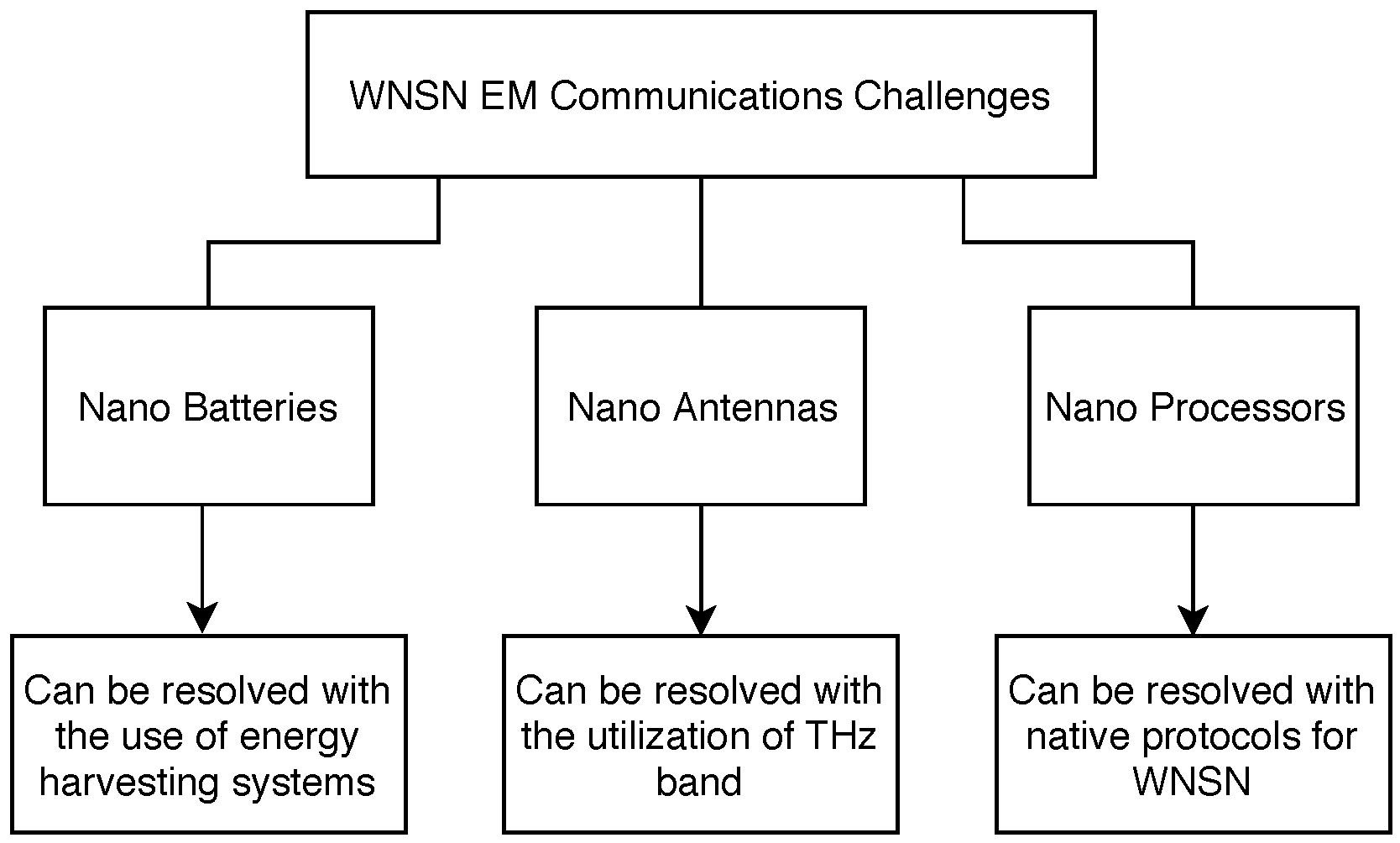
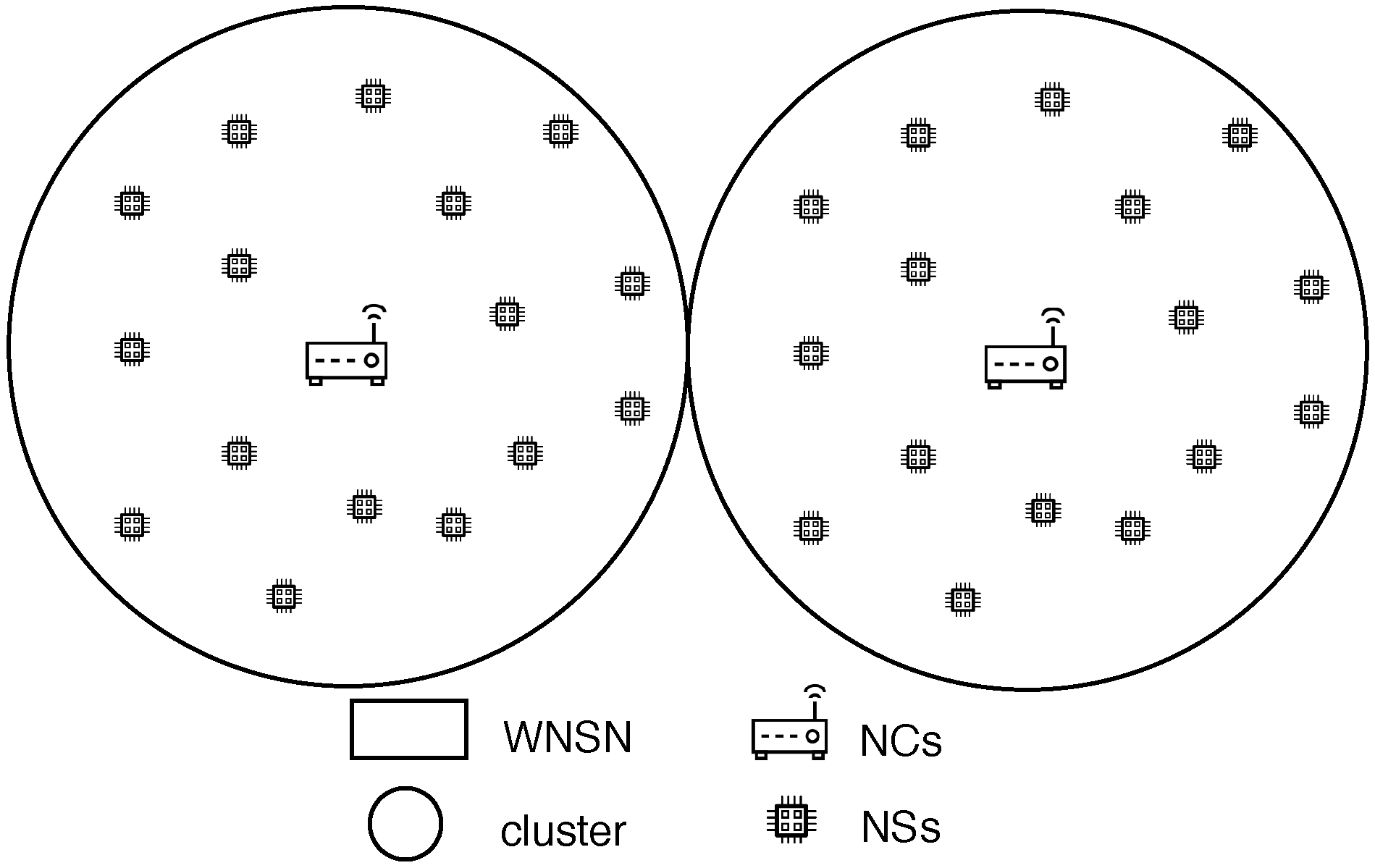

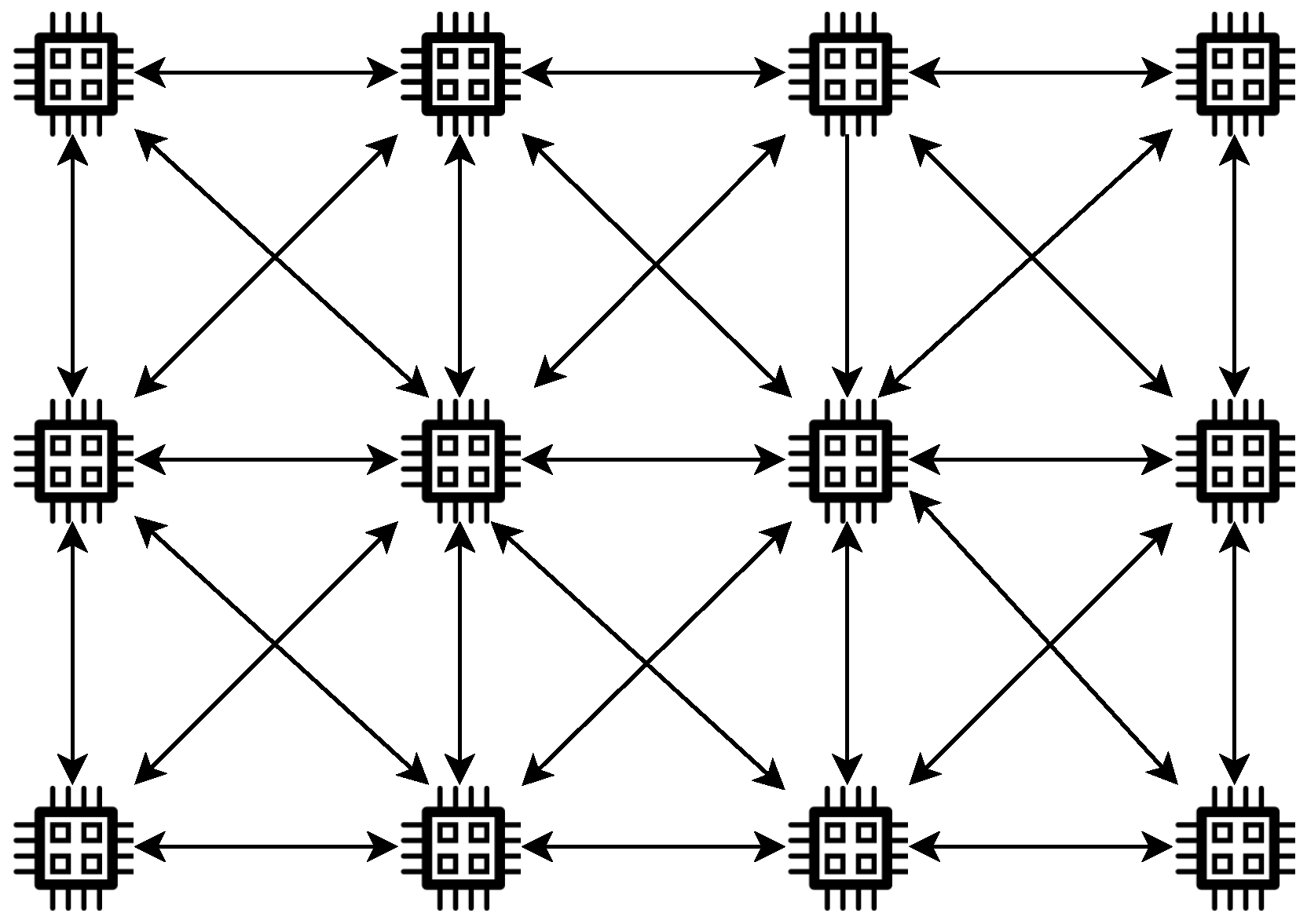
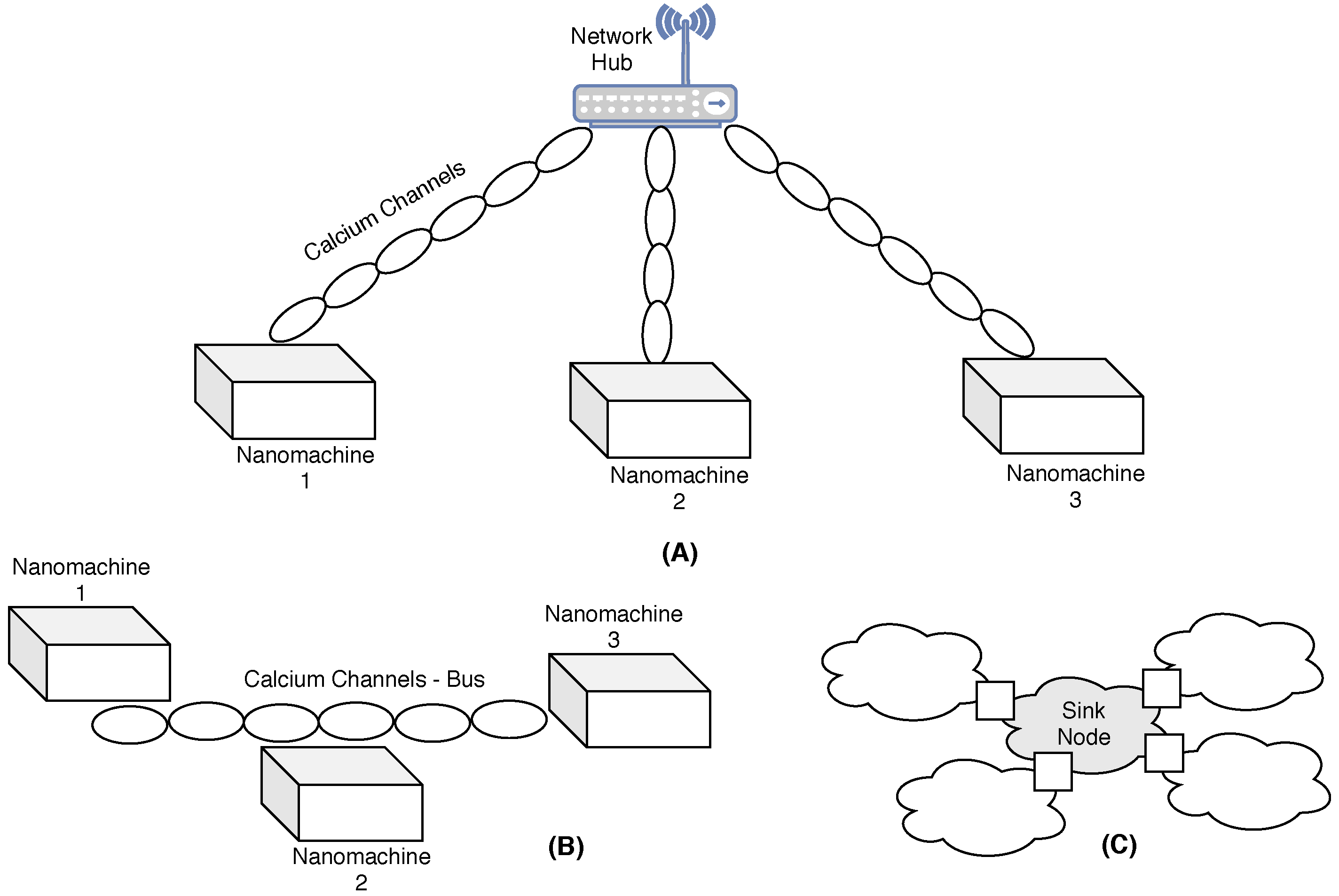


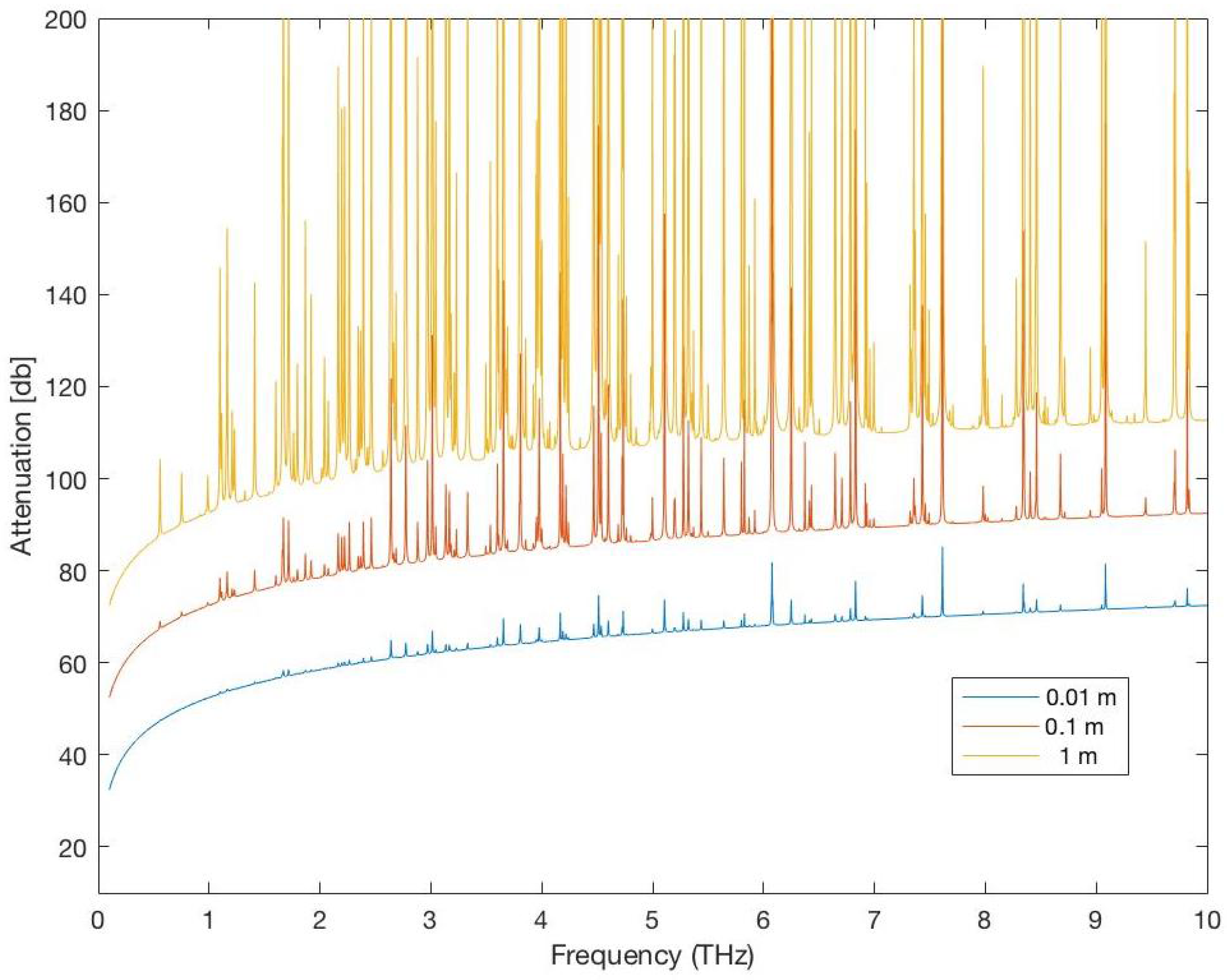
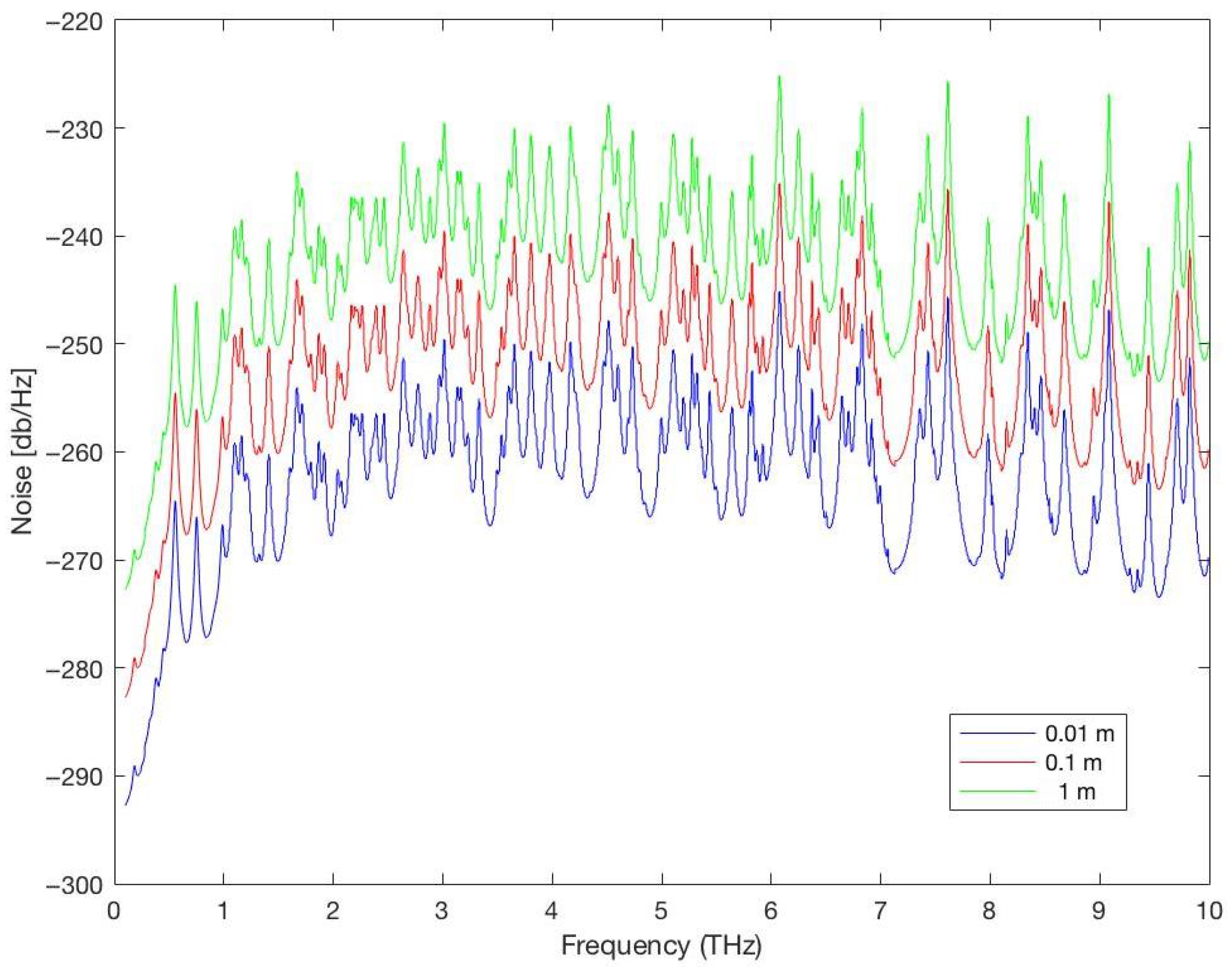
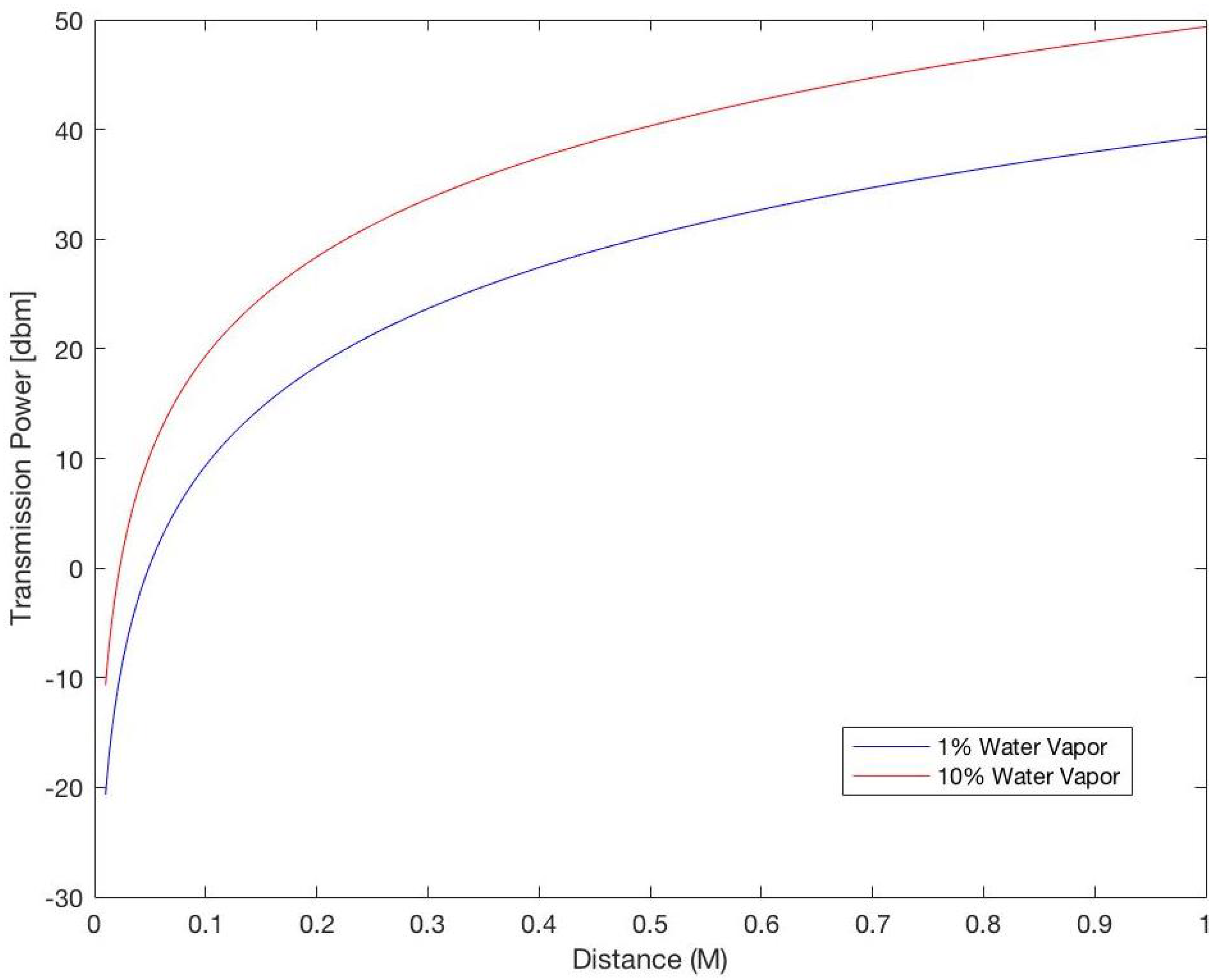
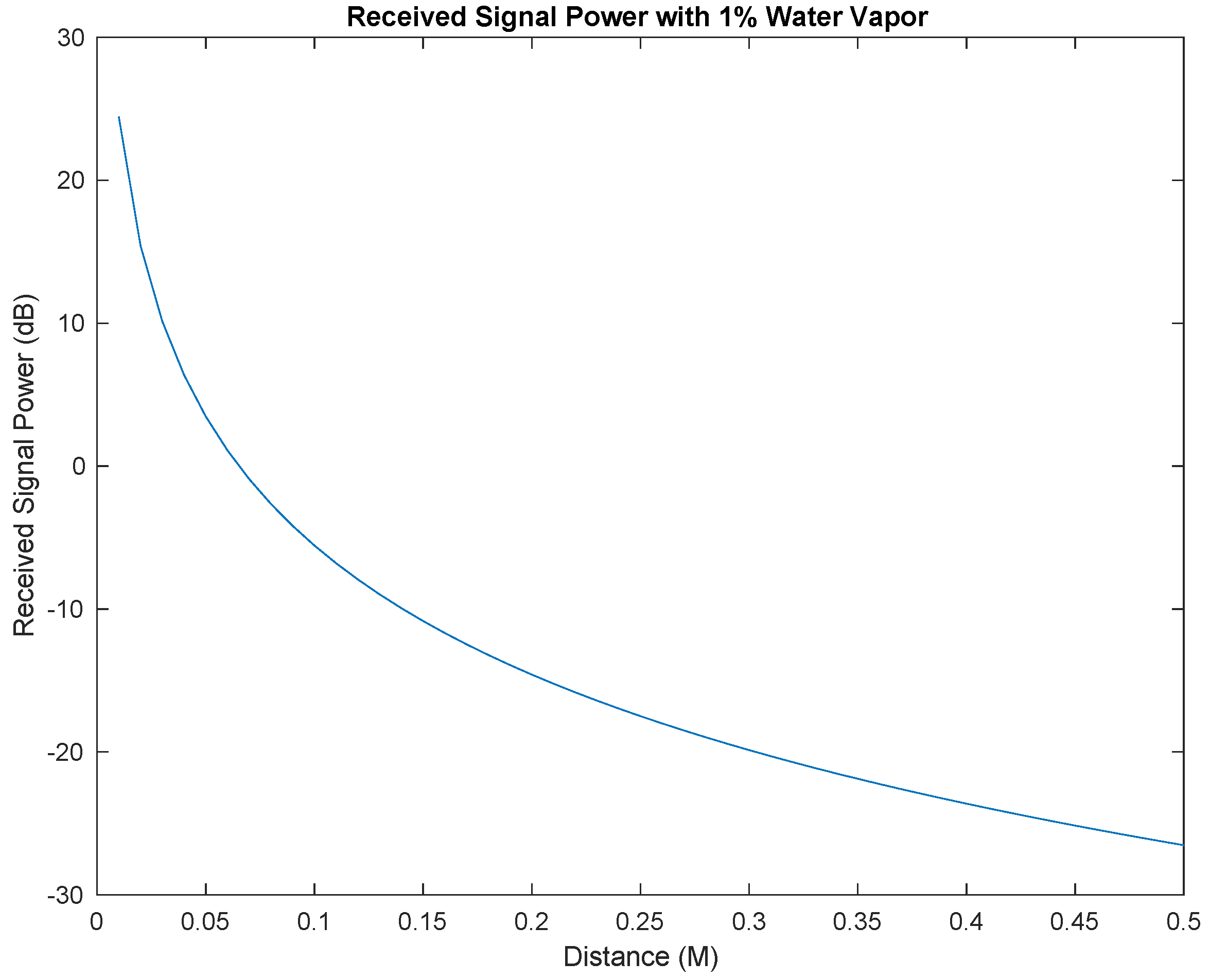
| Item | Sensor | Nanosensor |
|---|---|---|
| Size | Vary from the size of a shoe box to the size of a grain of dust | 10–100 m |
| Communication | Radio frequency (at 915 MHz and more recently 2.4 GHz) | Terahertz Band (0.1–10 THz) |
| Propagation Loss | Acceptable error rate | Very high propagation loss |
| Sensing Range | 20 m to 30 m for indoor and 75 m to 100 m for outdoor | 3 m |
| Transmission Range | 300 m for 900 MHz and 64 m for 2.4 GHz | Depends on the medium conditions, 0.03 m in medium with 1% water vapor using J |
| Centralized Topology | Distributed Topology | |||||||
|---|---|---|---|---|---|---|---|---|
| Paper | Key Concept | Cluster | Infrastructure | Mesh | Mobile NSs | Static NSs | 2D Environment | 3D Environment |
| [13] | Proposes EM-based WNSN architectures and discusses deployment considerations | x | x | |||||
| [30] | PSO-based mobility control to extend WNSN lifetime | x | x | x | ||||
| [44] | Introduces scalable nanomachine architecture applicable to deployment planning | x | ||||||
| [45] | Proposes SDM-based WNSN architecture influencing topology selection | x | x | |||||
| [46] | Biological communication model relevant for nanoscale deployment | x | x | |||||
| [47] | Evaluates THz propagation in plant monitoring deployments | x | x | x | ||||
| [49] | Graphene-grid placement for energy-efficient WNSN | x | x | x | ||||
| [50] | Fuzzy-logic mobility management for WNSNs | x | x | x | ||||
| [51] | 3D deployment model for in-body sensing | x | x | x | ||||
| [52] | AI-Driven Nano-Router Localization in WNSNs | x | x | x | x | |||
| [53] | PSO-driven self-deployment to improve coverage | x | ||||||
| [54] | Hop-count localization applicable to distributed deployment | x | x | x | ||||
| [55] | Forwarding mechanisms for EM WNSNs | x | x | x | ||||
| [56] | Routing and coordinates system influencing topology | x | x | x | x | |||
| [57] | Modulation strategy for better THz nanonetwork performance | x | x | x | ||||
| Reference | Deployment Type/Topology | Energy Efficiency | Coverage Ratio | Connectivity Performance | Key Observations |
|---|---|---|---|---|---|
| [30] | Distributed (PSO-based Mobility Control) | High—improved network lifetime | Improved-simulations | Stable under mobility | Effective for coverage and lifetime optimization, though computationally heavy. |
| [33] | Distributed Self-Deployment (PSO with Coverage Criterion) | Moderate—energy not prioritized | Full area coverage (k-covered) | Stable, adaptive | Strong self-organization; energy ignored. |
| [47] | Static Clustered 3D Deployment | Moderate—dependent on THz loss modeling | Not specified | Reliable | Suitable for plant and environmental monitoring. |
| [55] | Centralized Channel-Aware Forwarding | High—optimized transmission control | Not specified | Excellent; deterministic | Reliable but requires location awareness. |
| [56] | Distributed Dynamic Infrastructure (CORONA) | High—reduced retransmissions | Not specified | High; topology-aware | Improves routing reliability and link persistence. |
| [50] | Hybrid (Fuzzy Logic-based Mobility) | Moderate—depends on NC selection | Not specified | Stable; adaptive | Balanced load and link stability with fuzzy logic control. |
| [52] | AI-Driven/Mesh | Improved by shorter communication paths | 98.03% | Enhanced connectivity by ensuring nodes are within range of a nano-router | Highlights the potential of AI/ML strategies to address deployment challenges in dense nanoscale networks. |
Disclaimer/Publisher’s Note: The statements, opinions and data contained in all publications are solely those of the individual author(s) and contributor(s) and not of MDPI and/or the editor(s). MDPI and/or the editor(s) disclaim responsibility for any injury to people or property resulting from any ideas, methods, instructions or products referred to in the content. |
© 2025 by the authors. Licensee MDPI, Basel, Switzerland. This article is an open access article distributed under the terms and conditions of the Creative Commons Attribution (CC BY) license (https://creativecommons.org/licenses/by/4.0/).
Share and Cite
Bamuqabel, A.; Mahfoudh, S. Deployment Challenges in Electromagnetic Wireless Nanosensor Networks. Sensors 2025, 25, 7123. https://doi.org/10.3390/s25237123
Bamuqabel A, Mahfoudh S. Deployment Challenges in Electromagnetic Wireless Nanosensor Networks. Sensors. 2025; 25(23):7123. https://doi.org/10.3390/s25237123
Chicago/Turabian StyleBamuqabel, Amani, and Saoucene Mahfoudh. 2025. "Deployment Challenges in Electromagnetic Wireless Nanosensor Networks" Sensors 25, no. 23: 7123. https://doi.org/10.3390/s25237123
APA StyleBamuqabel, A., & Mahfoudh, S. (2025). Deployment Challenges in Electromagnetic Wireless Nanosensor Networks. Sensors, 25(23), 7123. https://doi.org/10.3390/s25237123






